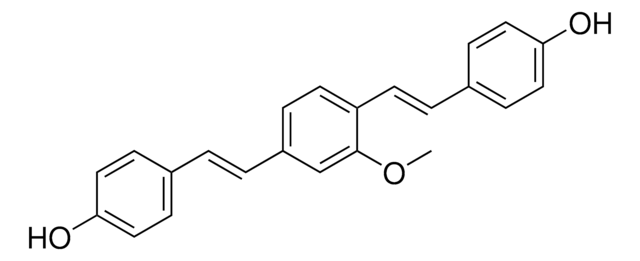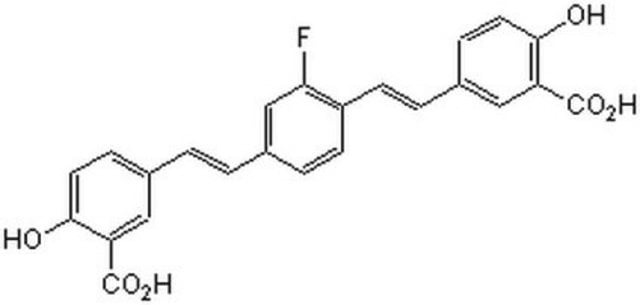SML1954
X-34
≥90% (HPLC), powder, amyloid-specific fluorescent dye
Sinonimo/i:
1,4-Bis(3-carboxy-4-hydroxyphenylethenyl)benzene
Autenticatiper visualizzare i prezzi riservati alla tua organizzazione & contrattuali
About This Item
Formula empirica (notazione di Hill):
C24H18O6
Numero CAS:
Peso molecolare:
402.40
Numero MDL:
Codice UNSPSC:
12352200
NACRES:
NA.77
Prodotti consigliati
product name
X-34, ≥90% (HPLC)
Livello qualitativo
Saggio
≥90% (HPLC)
Forma fisica
powder
Colore
white to beige
Solubilità
DMSO: 2.0 mg/mL, clear
Temperatura di conservazione
2-8°C
Stringa SMILE
OC(C=C1)=C(C(O)=O)C=C1C=CC2=CC=C(C=CC3=CC=C(O)C(C(O)=O)=C3)C=C2
Azioni biochim/fisiol
Fluorescent, amyloid-specific dye
X-34 (1,4-bis(3-carboxy-4-hydroxyphenylethenyl)-benzene) is one among the small-molecule γ-secretase modulators (GSMs) involved in lowering Aβ42 levels (the 42-residue isoform of the amyloid-β peptide). X-34 has also been used to visualize intracellular immunoreactive deposits with classic amyloid fibrillar ultrastructure in living transgenic Caenorhabditis elegans animals. It is also used as a histochemical stain for determining pathological changes in Alzheimer′s disease (AD).
X-34 is a fluorescent, amyloid-specific dye. It binds at a different site than Pittsburgh Compound B and is a highly fluorescent marker for beta-sheet structures.
Codice della classe di stoccaggio
11 - Combustible Solids
Classe di pericolosità dell'acqua (WGK)
WGK 3
Punto d’infiammabilità (°F)
Not applicable
Punto d’infiammabilità (°C)
Not applicable
Certificati d'analisi (COA)
Cerca il Certificati d'analisi (COA) digitando il numero di lotto/batch corrispondente. I numeri di lotto o di batch sono stampati sull'etichetta dei prodotti dopo la parola ‘Lotto’ o ‘Batch’.
Possiedi già questo prodotto?
I documenti relativi ai prodotti acquistati recentemente sono disponibili nell’Archivio dei documenti.
Substrate-targeting ?-secretase modulators
Kukar TL
Nature, 453, 925-929 (2008)
Andy P Tsai et al.
Neurobiology of disease, 153, 105303-105303 (2021-02-26)
Alzheimer's disease (AD) is a progressive neurodegenerative disorder characterized by cognitive decline, robust microgliosis, neuroinflammation, and neuronal loss. Genome-wide association studies recently highlighted a prominent role for microglia in late-onset AD (LOAD). Specifically, inositol polyphosphate-5-phosphatase (INPP5D), also known as SHIP1
Marcus Bäck et al.
Chemistry (Weinheim an der Bergstrasse, Germany), 22(51), 18335-18338 (2016-11-04)
Deposits comprised of amyloid-β (Aβ) are one of the pathological hallmarks of Alzheimer's disease (AD) and small hydrophobic ligands targeting these aggregated species are used clinically for the diagnosis of AD. Herein, we observed that anionic oligothiophenes efficiently displaced X-34
Chantal M Ferguson et al.
Alzheimer's & dementia : the journal of the Alzheimer's Association, 20(4), 2632-2652 (2024-02-20)
The most significant genetic risk factor for late-onset Alzheimer's disease (AD) is APOE4, with evidence for gain- and loss-of-function mechanisms. A clinical need remains for therapeutically relevant tools that potently modulate APOE expression. We optimized small interfering RNAs (di-siRNA, GalNAc)
Visualization of fibrillar amyloid deposits in living, transgenic Caenorhabditis elegans animals using the sensitive amyloid dye, X-34
Link CD
Neurobiology of Aging, 22, 217-226 (2001)
Il team dei nostri ricercatori vanta grande esperienza in tutte le aree della ricerca quali Life Science, scienza dei materiali, sintesi chimica, cromatografia, discipline analitiche, ecc..
Contatta l'Assistenza Tecnica.








